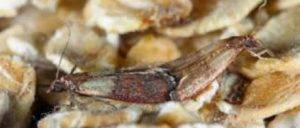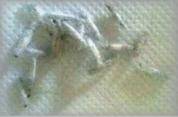Typically, pantry moths a rarely selective, and therefore you should store your food well to avoid contamination.
To know how to prevent or control them, you will need to know a number of pantry moth facts. In this comprehensive article, we delve into the most common basic info about these pests.
This article explores all about pantry moth facts, from what they eat, their relation to the common type of foods in the house, how they enter into containers and the seasons that they are most rampant.
While it is important to remove them from your house, knowing about them helps you make the best choice.
Sometimes all you need to do is to take a critical step of eliminating moths from their hideout. A word of caution: Avoid using pesticides to control these bugs, especially where you prepare food.
Also Read: Things to Do with Old Sinks: Steel, Porcelain or Composite
What do Pantry Moths Eat – some FAQs
Let us explore some of the questions that people ask relating the type of foods that pantry moths eat.
Do Pantry Moths Eat Sugar?
Yes, pantry moths eat sugar if it is exposed to them. They like feasting on foods with high sugar content. Such foods include sugar, chocolate, breakfast cereals, sugary dried fruit, and more. eating habits of these pantry moths concerning specific foods.
Are you sick and tired of watching the pantry moths destroy your food in the house? Deep down, you know it’s possible to eliminate them from your dwelling.
Keep reading, as you find out their eating habits and appropriate solutions.
Allow me to explain how they relate to your stored sugar. When the lifecycle reaches the caterpillar stage, the moths begin damaging your food.
As they grow, they will burrow into your sugar or other food sources and eat them up.
As the caterpillars develop into large enough, they begin to spin their cocoons on the food.
The moths will contaminate all the food that their larvae or pupae get in contact with. The infestation process is real quick since the entire lifecycle takes 6 to 8 weeks.
Do Pantry Moths Get into Sugar?
The answer might not surprise you because of a big percentage of pantry moths like sugar. They will invade your stored sugar and begin consuming it at all costs.
Mostly, people keep their sugar in cupboards and pantries, and these bugs can access and eat it mercilessly.
Indian meal moths are the most popular food moths in all the environments. They reproduce by depositing their eggs in food stores.
Overall, a female moth can lay about 400 eggs in a lifetime. These eggs take at least two days to hatch.
Do Pantry Moths Eat Spices?
Yes, pantry moths can feed on a variety of materials. They prefer dry pet foods and can also be found in foods people eat like spices, pasta, bread, rice, nuts, cereals, couscous, flour, powder milk, dry fruits, and dry animal food.
The pests can also infect packaged foods such as biscuits, cocoa beans, chocolate, coffee substitute, and tea bag boxes.
Infested food usually has the telltale sign of Frass, a cobweb-like substance made by Larvae. It is essential to identify and throw away infested food items.
Remember, just like many other pantry bugs in the house, pantry moths can squeeze into tight gaps and can chew through sealed bags.
Do Pantry Moths Eat Baking Soda?
Indian meal moths are aggressive bugs that will spread quickly to cover all available food sources.
The eggs of these moths mostly access our homes when their eggs come in food packages. As a result, they hatch into larvae and develop into adults.
Here are the details of the above answer: Pantry moths indeed eat baking soda.
They will surely damage it to change it from its natural state. So, it all adds up to this answer that baking soda is a delicacy for these bugs.
Do Pantry Moths Eat Salt?
Pantry moths consume every foodstuff, including salt. However, they like sugary food; hence, they will eat more sugar than salt. It will be a noble idea if you store your salt well because it is part of their delicacy.
Do Pantry Moths Eat Rice?
It is that simple that Indian meal moths will seek refuge in the food stores much celebrate as they encounter rice. Like other foodstuffs, the pantry moths will damage and contaminate these rice to unimaginable levels.
Also Read: How to Fix a Slow Draining Bathroom Drain not clogged
FAQs on How Pantry Moths Get into your Food
Moths access our homes through groceries. The favorable environment for moth’s growth includes food, moisture, air, and sunlight.
Moths will breed in the food areas within your cabinet or pantries to consume your dry stock.
Can Pantry Moths Get Into Tupperware?
So, what is the magic formula to keep them away naturally? Think of airtight containers to keep these bugs away.
Therefore, your food will be safer in Tupperware containers, which are available in different sizes.
One significant step to take is to refrigerate your food into the Tupperware container for at least two weeks.
After that, arrange them carefully in your pantries. The advantage of refrigerating these food paralyzes eggs for further reproduction.
So, will moths penetrate Tupperware? Make no mistake about it because moths will not get into the airtight Tupperware container.
These containers have a proper mechanism to keep these bugs away, thus protect the interior food.
How Do Moths get Into Sealed Containers?
Let’s recap what we mentioned earlier. Moths start multiplication from the eggs.
The moths lay these eggs on food areas or in the processing industry. High chances are that during packaging, these eggs may get into the packages.
Suppose you buy the affected food package and take it to your home, then the race begins.
While you may not know that your food has eggs, you innocently store them in a sealed container. The eggs will hatch into larvae, and reproduction continues.
In the long run, the caterpillars will feast on the food found in this sealed container and eventually damage and contaminate them.
Therefore, you should never store the food in the sealed containers without killing eggs by the refrigeration process.
Research indicates that moths do not operate optimally, with temperatures below 50F.
Therefore the only guarantee that the moths will never hatch is to perform prolonged freezing. Later, put the food in an airtight container.
Can Pantry Moths Get into Mason Jars?
Moths cannot enter the mason jars. Looking at it this way, the Mason jar is an airtight container that will protect the food from a further infestation of the moths.
The moths cannot eat up the materials used to develop the Mason jar for them to enter.

You will opt for the Mason jar because you want to preserve your food from potential damage from these bugs.
Spending a dollar in prevention is worthy than using 50 dollars to replace contaminated food.
You can avoid such losses by taking relevant measures to save you from any agony.
Keep doing until you experience a moth-free environment.
These insects are not there for any good rather than destruction, leading to the massive economic drain.
Can Pantry Moths get into Sealed Packages?
Yes. pantry moths can get into sealed packages, just in the same way they enter into tightly covered containers.
They enter into these packages by coming as eggs inside the food in the packages.
They also enter the packages by eating up the nylon or paper covers of the packages or the containers.
Therefore, protecting your food from any attack that comes from the pantry moths should be your top priority. Storing food in Mason jars is a purely natural way to end their influence.
The method is both chemical-free with no toxins to endanger human life. Therefore, it may not be possible to use in controlling other pantry pests in your house.
Can Pantry Moths Survive without Food?
Before I share it with you, it is better to understand the lifecycle of a pantry moth or any other type of a moth.
Forst its the egg, which hatches into larvae. the larva develops into a pupa, which brings forth an adult pantry moth.

Among the main pantry moth facts, you need to know is their life cycle.
An adult moth can survive without food for 1 to 2 weeks before it dies.
While starving, the female moth will still lay eggs which procures the lifecycle.
One thing for sure is the lifecycle differs, ranging from 30 days to 300 days.
Take note that larvae can lie dormant for months but eventually develop to another stage. Then the lifecycle begins again.
Are Pantry Moths Seasonal?
Pantry moths have a continuous lifecycle as long as conditions to make them reproduce are intact. If there is plenty of food in their environment, these bugs will multiply fast to dominate the territory.
Whenever the season they appear in your house, be armed with some traps that work, and other methods applied to eliminate the pests. Removing pantry moths as soon as possible is important because it avoids sustained hatching of eggs.
As mentioned earlier, the remote conditions like low temperatures will slow the activities of these insects, including reproduction.
Also, a lack of food can temporality stall their multiplication, but that does not mean that they are seasonal.
How to Prevent Pantry Moths in the Kitchen
Have you ever dealt with pantry a moth infestation? It can be one of the most frustrating experiences. Pantry moths thrive almost anywhere inside a home.
These pests are frequent unwelcome guests that can pose a health risk if they get into your food.
If you think you have pantry moths in your home, first check everything in your pantry and kitchen cabinets. These are the places you can easily spot them.
Check the food containers, cardboard boxes, or packaging plastic bags for small holes. After that, get the right pantry moth killers to trap and kill them.
If there are any infested foods, discard far away from home.
To prevent pantry moths’ infestation:
- Always keep the kitchen and your home clean. It gives the pests less chance of thriving.
- Wipe food containers, shelves, and other areas with white vinegar.
- Before you buy packaged foods, check for signs of infestation.
- Make sure you kill any moths and larvae that may come with the groceries. Storing grain food products in the freezer for the first four days after buying them will help to kill the pests.
- Store unrefrigerated food grain products in airtight containers.
- Place some bay leaves in the food grain containers. The smell of the leaves keeps moths away.
Also Read: Offset Kitchen Sink pros and cons: 7 Best Offset Sinks 2021
Common FAQs on where Pantry Moths live
Can Pantry Moths Live or Survive in the Refrigerator?
No. Though pantry moths can live almost anywhere in the home; they can’t survive place with freezing temperatures.
It is the reason why it is advisable to store food grain products in the refrigerator for some days after shopping for groceries.
Freeze the food for a week, then remove it for a few days, and refreeze it for another week.
Pests are cold-blooded, and you can use high or low temperatures to control pantry moth infestation. Temperatures of about 80°F are the most favorable for pantry pests.
Temperatures above 95°F or below 60°F significantly reduce the reproduction and survival of the pest.
Can Pantry Moths Stay in the Bedroom?
Yes. Pantry moths can infect anywhere in the home, including the bedroom. These pests thrive in dark areas, and in the bedroom, you are likely to find them hiding in closets and corners.
To prevent them from infesting your bedroom, apply the following measures:

- Use temperature control. It is one of the most efficient means of controlling pantry moths.
- Throw away any food contaminated by moths
- Avoid keeping foodstuffs in the bedroom
- Install light bulbs to light your closet well
- Use natural moth repellents
- Wash and iron your clothes
- Use moth poison and balls
- Use of a dehumidifier
- Vacuum and clean
Can Pantry Moths get or Live in Clothes
Pantry moths form a large superfamily of moths, known as the Pyraloida. The family has many species, including the clothes moth.
This type of moth eats cotton, wool, silk, and natural fibers found in clothing, bedding, drapes, upholstery, and carpet.

Clothes moth can enter the home through new purchases, especially from resale shops, infected with the eggs. Food stains, urine, sweat, and moisture also attract adult moths.
It is essential to maintain a clean home to prevent moth infestations. Also, clean your clothes before storing them. It is highly recommended to dry-cleaning wool, silk, and other delicate fabrics.
Can Pantry Moths’ Larvae get into the Ceiling?
Yes. If your home has a pantry moth infestation, you are likely to discover small moths in the kitchen, and also maggots crawling on the ceilings in your home. Pantry moths spin cocoons in rooms other than the pantry or kitchen where they hatched. Often, you will see them crawling on walls and ceilings in different places.
When the larvae are ready to pupate, they leave the food had been feeding on. The larvae can travel significant distances looking for protected areas to pupate and turn into adult moths.
Usually, they crawl upward, ending up in a corner, wall, crack, or the ceiling where they make a silken cocoon.
How Long do Pantry Moths Live? How do They Reproduce?
The lifecycle of pantry moths varies depending on the environment. It ranges from 30 days to 300 days. The lifecycle of pantry moths has four stages, including:
- The egg stage takes between 2 to 14 days to hatch.
- Larvae stage ranges from 40 days to 210 days.
- The pupae stage has an average of 14 days.
- The adult stage varies depending on the temperature and the sex of the moth from one day and over 19 days.
Pantry moths lay their eggs in foods such as seeds, cereals, grains, flours, dried food, powder milk, grain products, chocolates, dried fruit, candy, and often dry pet foods.
How Often do Pantry Moths Lay Eggs?
Pantry moths can take from 25 to 135 days to lay eggs. It all depends on the temperature and environmental conditions. The moths live for longer in cooler than in warm climates.
A female pantry moth can lay between 100 and 400 eggs over a one to 18-day period. The female moth lays clusters during the night.
The females prefer areas where the hatched larvae can quickly get food. Often, they put the eggs directly onto the food.
The eggs are white or gray. However, the individual eggs are tiny and hard to see with the naked eyes.
Also Read: How to Vent a Kitchen Sink Drain: Steps with pipe Diagrams
Final Thoughts
Like everything else, nobody wants to live with destructive bugs. Pantry moths are insects that you should avoid by all means. It is better to prevent them early or regret later.
In this regard, you should take appropriate measures to get rid of moths before they destroy your valuables. You can follow the simple procedures to keep your food and also consult an expert for other options to pursue.
The bottom line is this: Getting rid of these insects will preserve your food and save your clothes and other fabrics from any attack.
A healthy and fulfilling life begins when you keep the pantry moths away forever. And doing this, all you need to know is the pantry moth facts and basics about the pests.
Want to know more about the pantry moth life cycle? watch it below


I am a homeowner excited by various innovative products and solutions that make life better. I am happy to share such ideas and reviews of home and related products.
